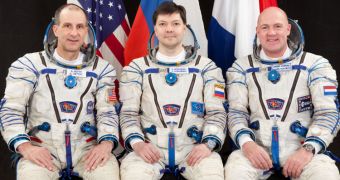Officials with the European Space Agency (ESA) announce that the next astronaut to fly to the International Space Station (ISS) on its behalf will be André Kuipers, aboard the Soyuz TMA-03M space capsule.
The mission, which will deliver three astronauts belonging to the Expedition 30 crew, will launch on December 21, from the Baikonur Cosmodrome, in the steppes of Kazakhstan. Takeoff will occur just days before Christmas, giving the three crewmembers the best present they could wish for.
Kuipers will be joined inside the Soyuz vehicle by NASA astronaut Don Pettit, and Russian cosmonaut Oleg Kononenko, from the Russian Federal Space Agency (RosCosmos). They will represent the second half of Expedition 30, and the first half of Expedition 31.
RosCosmos flight engineer Sergey Volkov, Japan Aerospace Exploration Agency (JAXA) taikonaut Satoshi Furukawa and NASA astronaut Michael Fossum – the crew currently aboard the ISS – are scheduled to return to Earth on November 21.
However, the space facility will not be left unmanned for a month, as some feared. The next Soyuz flight, carried out on the TMA-22 spacecraft, will occur on November 14. If everything goes according to plan, then the Expedition 29 crew and their Expedition 30 colleagues will have a few days in space together.
NASA astronaut Dan Burbank and Russian cosmonauts Anton Shkaplerov and Anatoli Ivanishin are scheduled to dock to the ISS on November 16, spending a little less than a week with their departing colleagues. The Expedition 30 crew will then be made whole, about a month later.
“During his 5-month PromISSe mission, André will conduct more than 20 ESA experiments and around 15 from other Station partners, including human research, life sciences, physics, materials science, radiation research and technology demonstrations,” an ESA press release reads.
“The lessons from space will educate children in science, technology, engineering and mathematics, as well as teaching about the requirements for life on Earth,” the announcement goes on to explain.
“As part of ‘Mission-X: Train Like an Astronaut’, André will invite thousands of students to perform physical exercises and classroom lessons to compete with teams around the world to become as fit as astronauts,” the statement concludes.

 14 DAY TRIAL //
14 DAY TRIAL //